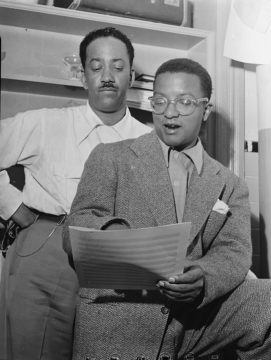by Dick Edelstein

Although jazz pianist, composer, arranger and lyricist Billy Strayhorn died in 1967 at the age of 51, his obscure life has since then become much better known than it was during his lifetime. His songs remain popular, and his reputation has continued to grow. Strayhorn shares credit for many jazz tunes he composed and arranged in collaboration with Duke Ellington and contributed without credit to others, such as the popular “Satin Doll”, but none of these tunes illustrate his importance and success as a jazz composer better than “Lush Life” and “Take the A Train”. The latter not only became the theme song of the Ellington orchestra but also one of its greatest successes and an anthem of the swing era. The lyrics of this song came from notes that Strayhorn took when he came to New York to work for Ellington for the first time, when he was only 23 years old. Ellington had given him directions on the easiest way to get to his house in Harlem – by taking the A train. The song has gone on to become one of the great jazz tunes both in its version with lyrics and as an instrumental.
Let’s consider one of Strayhorn’s most popular compositions, Lush Life, recorded by dozens of jazz artists over the years, and in recent years by Lady Gaga and Queen Latifa. For many jazz fans, one of the most memorable recordings of this song is the John Coltrane and Johnny Hartman version on their album released by Impulse! in 1963, which was inducted into the Grammy Hall of Fame in 2000. Most of the lyrics were written when Strayhorn was still in high school, living in Pittsburgh. In a world-weary tone, the lyrics speak of night life following a failed romance. They represent a young boy’s fantasy about a sophisticated life seen from the point of view of a jaded bon vivant. Remarkably, they also describe the sort of life that, against all odds, Strayhorn was eventually to lead.
Some of the songs resulting from Ellington and Strayhorn’s frequent collaboration were attributed to both of them while others were credited to Ellington only, and some eventually assigned to Strayhorn. Even to this day, it is unclear who did what and there are several reasons for this. First, in those days it was common for bandleaders to take credit for songs worked on by other composers and arrangers. But there was an important additional reason: Ellington did his best to protect Strayhorn. Billy Strayhorn was openly gay, a situation that was very unusual for jazz musicians at the time. Strayhorn’s openness did not extend to his public reputation and Ellington feared that, because of the great public attention his orchestra attracted, it would be difficult for Strayhorn to defend himself if he was too much in the public eye. Ellington helped to safeguard Strayhorn’s privacy and when the young arranger first came to New York to work for Ellington, he went directly to live in Ellington’s house, where he was treated like a family member.
Strayhorn made important contributions to most of Ellington’s extended jazz pieces, usually called “suites”, pieces that often satisfied the demands made by concert and festival organizers. Many supporters saw these pieces as proof that Ellington was “just as good” as contemporary classical music composers and these works contributed to Ellington’s stature. It is now recognized that Billy Strayhorn’s contribution to these pieces was significant and several of the later pieces credited him as co-composer.
Another facet of Strayhorn’s musicianship can be seen in his work on a series of records with Ellington’s lead alto sax player Johnny Hodges, which gives listeners a rare glimpse of his style as a pianist. Almost all of the musicians on these recordings came from the Ellington orchestra and these sessions featured Strayhorn’s arrangements and gave him a chance to be heard as a pianist. These recordings showcase some of Strayhorn’s multiple talents, which were well known in the jazz musicians’ community but much less to the public.
The confusion surrounding the authorship of the songs and compositions Ellington and Strayhorn collaborated on is unlikely to be resolved. Undoubtedly Ellington appropriated the rights of some of the songs that Strayhorn helped to compose and arrange. To his credit, on various occasions, in statements laden with typical Ellingtonian irony, he acknowledged the nature of their professional relationship and how dependent he was on Strayhorn for meeting the demands of his major compositions in particular. Ellington had a special relationship with his great friend and musical collaborator. He was a great developer of talent and Billy Strayhorn was one of the greatest talents whose career was associated with the Duke Ellington Orchestra. It is fitting to end with Ellington’s comment about Strayhorn: “Billy Strayhorn was my right arm, my left arm, all the eyes in the back of my head, my brain waves in his head, and his in mine.”
Photo credit: William P. Gottlieb/Ira and Leonore S. Gershwin Fund Collection, Music Division, Library of Congress.
